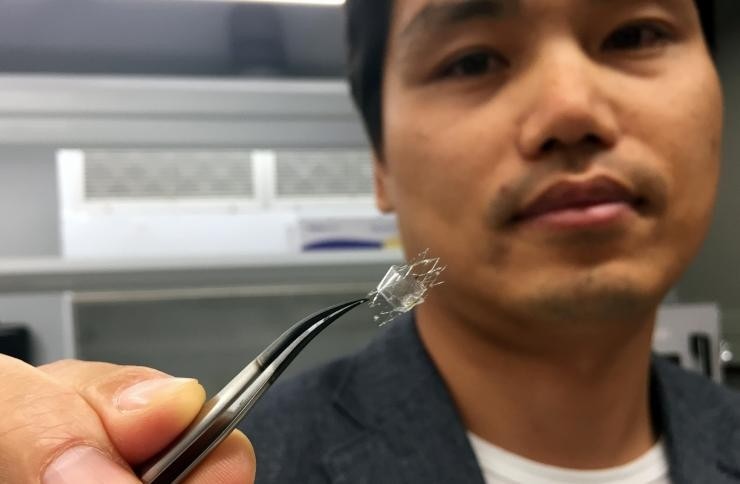Aug 7 2018
A stent-like flow diverter that can be implanted could provide one alternative for less invasive treatment of brain aneurysms - bulges in blood vessels - but the procedure necessitates repeated monitoring while the vessels heal. Currently, a multi-university research team has shown proof-of-concept for an extremely flexible and stretchable sensor that could be incorporated with the flow diverter to track hemodynamics in a blood vessel without expensive diagnostic procedures.
 Image credit: Georgia Tech
Image credit: Georgia Tech
The sensor, which uses variations in capacitance to measure blood flow, could decrease the need for testing to track the flow via the diverter. Scientists, led by Georgia Tech, have demonstrated that the sensor accurately measures fluid flow in animal blood vessels in vitro, and are involved in the next challenge: wireless operation that could enable in vivo testing.
The study was published in the July 18th issue of the journal ACS Nano and was financed by multiple grants from Georgia Tech’s Institute for Electronics and Nanotechnology, the University of Pittsburgh and the Korea Institute of Materials Science.
“The nanostructured sensor system could provide advantages for patients, including a less invasive aneurysm treatment and an active monitoring capability,” said Woon-Hong Yeo, an assistant professor in Georgia Tech’s George W. Woodruff School of Mechanical Engineering and Wallace H. Coulter Department of Biomedical Engineering at Georgia Tech and Emory University. “The integrated system could provide active monitoring of hemodynamics after surgery, allowing the doctor to follow up with quantitative measurement of how well the flow diverter is working in the treatment.”
Cerebral aneurysms occur in nearly 5% of the population, with each aneurysm bearing a one percent risk annually of rupturing, observed Youngjae Chun, an associate professor in the Swanson School of Engineering at the University of Pittsburgh. Aneurysm rupture will cause fatality in up to half of affected patients.
Endovascular therapy using platinum coils to fill the aneurysm sac has become the typical treatment for the majority of aneurysms, but of late, a new endovascular method—a flow diverter—has been designed to treat cerebral aneurysms. Flow diversion requires positioning a porous stent across the neck of an aneurysm to redirect flow away from the sac, creating local blood clots inside the sac.
“We have developed a highly stretchable, hyper-elastic flow diverter using a highly-porous thin film nitinol,” Chun explained. “None of the existing flow diverters, however, provide quantitative, real-time monitoring of hemodynamics within the sac of cerebral aneurysm. Through the collaboration with Dr. Yeo's group at Georgia Tech, we have developed a smart flow-diverter system that can actively monitor the flow alterations during and after surgery.”
For the damaged artery to be repaired takes months or even years, during which the flow diverter must be observed using MRI and angiogram technology, which is expensive and involves a magnetic dye to be injected into the bloodstream. Yeo and his colleagues are optimistic their sensor could provide easier monitoring in a doctor’s office using a wireless inductive coil to transmit electromagnetic energy via the sensor. By measuring how the energy’s resonant frequency changes as it flows via the sensor, the system could measure blood flow variations into the sac.
“We are trying to develop a batteryless, wireless device that is extremely stretchable and flexible that can be miniaturized enough to be routed through the tiny and complex blood vessels of the brain and then deployed without damage,” said Yeo. “It’s very challenging to insert such electronic system into the brain’s narrow and contoured blood vessels.”
The sensor uses a micro-membrane composed of two metal layers surrounding a dielectric material, and wraps around the flow diverter. The device is only a few hundred nanometers thick, and is made using nanofabrication and material transfer printing methods, compressed in a soft elastomeric material.
“The membrane is deflected by the flow through the diverter, and depending on the strength of the flow, the velocity difference, the amount of deflection changes,” Yeo explained. “We measure the amount of deflection based on the capacitance change, because the capacitance is inversely proportional to the distance between two metal layers.”
Since the brain’s blood vessels are very small, the flow diverters cannot exceed more than five to ten millimeters long and a few millimeters in diameter. That eliminates the use of conventional sensors with stiff and bulky electronic circuits.
“Putting functional materials and circuits into something that size is pretty much impossible right now,” Yeo said. “What we are doing is very challenging based on conventional materials and design strategies.”
The scientists tried out three materials for their sensors: magnesium, gold, and the nickel-titanium alloy known as nitinol. All of them are safe to use in the body, but magnesium offers the possibility of dissolving into the bloodstream after it is no longer required.
The proof-of-concept sensor was linked to a guide wire in the in vitro testing, but Yeo and his colleagues are currently involved in creating a wireless version that could be implanted in a living animal model. While implantable sensors are being used clinically to observe abdominal blood vessels, application in the brain poses major challenges.
“The sensor has to be completely compressed for placement, so it must be capable of stretching 300 or 400 percent,” said Yeo. “The sensor structure has to be able to endure that kind of handling while being conformable and bending to fit inside the blood vessel.”
The study included many contributors from various institutions, including Connor Howe from Virginia Commonwealth University; Saswat Mishra and Yun-Soung Kim from Georgia Tech, Youngjae Chun, Yanfei Chen, Sang-Ho Ye and William Wagner from the University of Pittsburgh; Jae-Woong Jeong from the Korea Advanced Institute of Science and Technology; Hun-Soo Byun from Chonnam National University; and Jong-Hoon Kim from Washington State University.